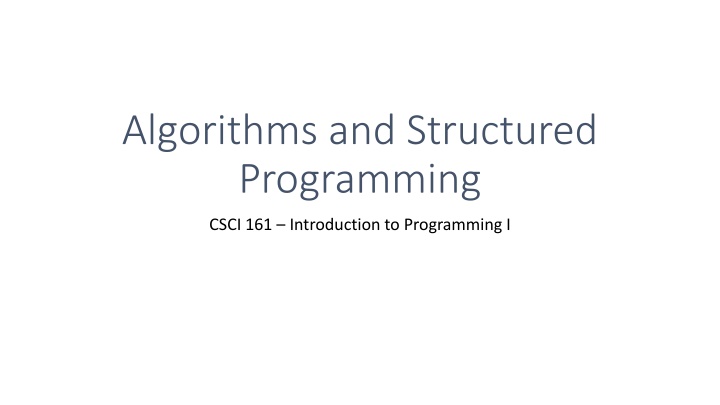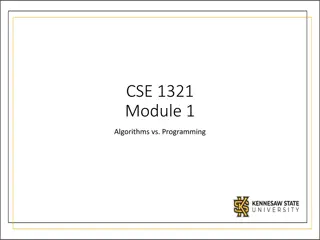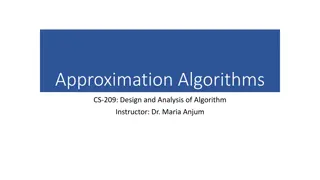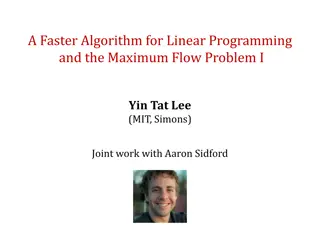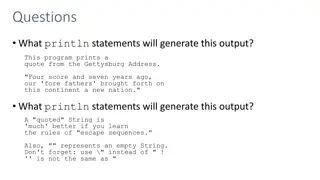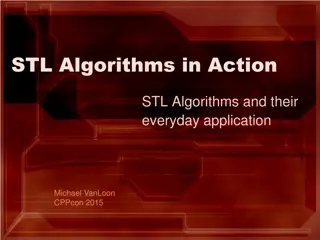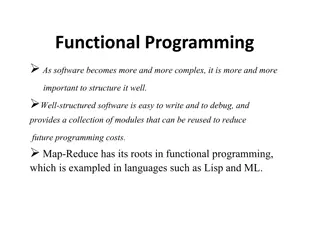Introduction to Algorithms and Structured Programming
This content introduces algorithms, structured programming, and the importance of structuring tasks to avoid redundancy. It demonstrates how algorithms can be organized, refined, and made more efficient. The examples provided highlight the significance of following a structured approach in problem-solving and coding. Through illustrations and explanations, you will grasp the concept of algorithms and understand how to create well-structured programs for efficient problem-solving in programming.
Download Presentation

Please find below an Image/Link to download the presentation.
The content on the website is provided AS IS for your information and personal use only. It may not be sold, licensed, or shared on other websites without obtaining consent from the author.If you encounter any issues during the download, it is possible that the publisher has removed the file from their server.
You are allowed to download the files provided on this website for personal or commercial use, subject to the condition that they are used lawfully. All files are the property of their respective owners.
The content on the website is provided AS IS for your information and personal use only. It may not be sold, licensed, or shared on other websites without obtaining consent from the author.
E N D
Presentation Transcript
Algorithms and Structured Programming CSCI 161 Introduction to Programming I
Algorithms algorithm: a list of steps for solving a problem Example algorithm: "Bake sugar cookies" oMix the dry ingredients. oCream the butter and sugar. oBeat in the eggs. oStir in the dry ingredients. oSet the oven temperature. oSet the timer. oPlace the cookies into the oven. oAllow the cookies to bake. oSpread frosting and sprinkles onto the cookies. o...
Problems with algorithms lack of structure: Many tiny steps; tough to remember redundancy: Consider making a double batch... o Mix the dry ingredients. o Cream the butter and sugar. o Beat in the eggs. o Stir in the dry ingredients. o Set the oven temperature. o Set the timer. o Place the first batch of cookies into the oven. o Allow the cookies to bake. o Set the timer. o Place the second batch of cookies into the oven. o Allow the cookies to bake. o Mix ingredients for frosting. o ...
Structured algorithms structured algorithm: Split into coherent tasks. 1 Make the cookie batter. o Mix the dry ingredients. o Cream the butter and sugar. o Beat in the eggs. o Stir in the dry ingredients. 2 Bake the cookies. o Set the oven temperature. o Set the timer. o Place the cookies into the oven. o Allow the cookies to bake. 3 Add frosting and sprinkles. o Mix the ingredients for the frosting. o Spread frosting and sprinkles onto the cookies. ...
Removing redundancy A well-structured algorithm can describe repeated tasks with less redundancy 1 Make the cookie batter. oMix the dry ingredients. o... 2a Bake the cookies (first batch). oSet the oven temperature. oSet the timer. o... 2b Bake the cookies (second batch). 3 Decorate the cookies. o...
A program with redundancy public class BakeCookies { public static void main(String[] args) { System.out.println("Mix the dry ingredients."); System.out.println("Cream the butter and sugar."); System.out.println("Beat in the eggs."); System.out.println("Stir in the dry ingredients."); System.out.println("Set the oven temperature."); System.out.println("Set the timer."); System.out.println("Place a batch of cookies into the oven."); System.out.println("Allow the cookies to bake."); System.out.println("Set the oven temperature."); System.out.println("Set the timer."); System.out.println("Place a batch of cookies into the oven."); System.out.println("Allow the cookies to bake."); System.out.println("Mix ingredients for frosting."); System.out.println("Spread frosting and sprinkles."); } }
Static methods static method: A named group of statements. odenotes the structure of a program oeliminates redundancy by code reuse class method A statement statement statement procedural decomposition: odividing a problem into methods method B statement statement method C statement statement statement Writing a static method is like adding a new command to Java.
Using static methods 1. Design the algorithm. oLook at the structure, and which commands are repeated. oDecide what are the important overall tasks. 2. Declare (write down) the methods. oArrange statements into groups and give each group a name. 3. Call (run) the methods. oThe program's main method executes the other methods to perform the overall task.
Design of an algorithm // This program displays a delicious recipe for baking cookies. public class BakeCookies2 { public static void main(String[] args) { // Step 1: Make the cake batter. System.out.println("Mix the dry ingredients."); System.out.println("Cream the butter and sugar."); System.out.println("Beat in the eggs."); System.out.println("Stir in the dry ingredients."); // Step 2a: Bake cookies (first batch). System.out.println("Set the oven temperature."); System.out.println("Set the timer."); System.out.println("Place a batch of cookies into the oven."); System.out.println("Allow the cookies to bake."); // Step 2b: Bake cookies (second batch). System.out.println("Set the oven temperature."); System.out.println("Set the timer."); System.out.println("Place a batch of cookies into the oven."); System.out.println("Allow the cookies to bake."); // Step 3: Decorate the cookies. System.out.println("Mix ingredients for frosting."); System.out.println("Spread frosting and sprinkles."); } }
Declaring a method Gives your method a name so it can be executed Syntax: public static void name() { statement; statement; ... statement; } Example: public static void printWarning() { System.out.println("This product causes cancer"); System.out.println("in lab rats and humans."); }
Calling a method Executes the method's code Syntax: name(); oCan call same method many times if you like Example: printWarning(); oOutput: This product causes cancer in lab rats and humans.
Program with static method public class FreshPrince { public static void main(String[] args) { rap(); // Calling (running) the rap method System.out.println(); rap(); // Calling the rap method again } // This method prints the lyrics to my favorite song. public static void rap() { System.out.println("Now this is the story all about how"); System.out.println("My life got flipped turned upside-down"); } } Output: Now this is the story all about how My life got flipped turned upside-down Now this is the story all about how My life got flipped turned upside-down
Final cookie program // This program displays a recipe for cookies. public class BakeCookies3 { public static void main(String[] args) { makeBatter(); bake(); // 1st batch bake(); // 2nd batch decorate(); } // Step 1: Make the cake batter. public static void makeBatter() { System.out.println("Mix the dry ingredients."); System.out.println("Cream the butter and sugar."); System.out.println("Beat in the eggs."); System.out.println("Stir in the dry ingredients."); } // Step 2: Bake a batch of cookies. public static void bake() { System.out.println("Set the oven temperature."); System.out.println("Set the timer."); System.out.println("Place a batch of cookies into the oven."); System.out.println("Allow the cookies to bake."); } // Step 3: Decorate the cookies. public static void decorate() { System.out.println("Mix ingredients for frosting."); System.out.println("Spread frosting and sprinkles."); } }
Methods calling methods public class MethodsExample { public static void main(String[] args) { message1(); message2(); System.out.println("Done with main."); } public static void message1() { System.out.println("This is message1."); } public static void message2() { System.out.println("This is message2."); message1(); System.out.println("Done with message2."); } } Output?
Control flow When a method is called, the program's execution... o"jumps" into that method, executing its statements, then o"jumps" back to the point where the method was called. public class MethodsExample { public static void main(String[] args) { message1(); message2(); public static void message1() { System.out.println("This is message1."); } public static void message2() { System.out.println("This is message2."); message1(); System.out.println("Done with main."); } System.out.println("Done with message2."); } ... } public static void message1() { System.out.println("This is message1."); }
When to use methods Place statements into a static method if: oThe statements are related structurally, and/or oThe statements are repeated. You should not create static methods for: oAn individual println statement. oOnly blank lines. (Put blank printlns in main.) oUnrelated or weakly related statements. (Consider splitting them into two smaller methods.)
Drawing complex figures with static methods
Static methods question Write a program to print these figures using methods ______ / \ / \ \ / \______/ \ / \______/ +--------+ ______ / \ / \ | STOP | \ / \______/ ______ / \ / \ +--------+
Development strategy ______ / \ / \ \ / \______/ First version (unstructured): Create an empty program and main method. \ / \______/ +--------+ Copy the expected output into it, surrounding each line with System.out.println syntax. ______ / \ / \ | STOP | \ / \______/ Run it to verify the output. ______ / \ / \ +--------+
Program version 1 public class Figures1 { public static void main(String[] args) { System.out.println(" ______"); System.out.println(" / \\"); System.out.println("/ \\"); System.out.println("\\ /"); System.out.println(" \\______/"); System.out.println(); System.out.println("\\ /"); System.out.println(" \\______/"); System.out.println("+--------+"); System.out.println(); System.out.println(" ______"); System.out.println(" / \\"); System.out.println("/ \\"); System.out.println("| STOP |"); System.out.println("\\ /"); System.out.println(" \\______/"); System.out.println(); System.out.println(" ______"); System.out.println(" / \\"); System.out.println("/ \\"); System.out.println("+--------+"); } }
Development strategy 2 ______ / \ / \ \ / \______/ Second version (structured, with redundancy): Identify the structure of the output. \ / \______/ +--------+ Divide the main method into static methods based on this structure. ______ / \ / \ | STOP | \ / \______/ ______ / \ / \ +--------+
Output structure ______ / \ / \ \ / \______/ The structure of the output: initial "egg" figure second "teacup" figure third "stop sign" figure fourth "hat" figure \ / \______/ +--------+ ______ / \ / \ | STOP | \ / \______/ This structure can be represented by methods: drawEgg drawTeaCup drawStopSign ______ / \ / \ +--------+ drawHat
Program version 2 public class Figures2 { public static void main(String[] args) { drawEgg(); drawTeaCup(); drawStopSign(); drawHat(); } public static void drawEgg() { System.out.println(" ______"); System.out.println(" / \\"); System.out.println("/ \\"); System.out.println("\\ /"); System.out.println(" \\______/"); System.out.println(); } public static void drawTeaCup() { System.out.println("\\ /"); System.out.println(" \\______/"); System.out.println("+--------+"); System.out.println(); } ...
Program version 2, cont'd. ... public static void drawStopSign() { System.out.println(" ______"); System.out.println(" / \\"); System.out.println("/ \\"); System.out.println("| STOP |"); System.out.println("\\ /"); System.out.println(" \\______/"); System.out.println(); } public static void drawHat() { System.out.println(" ______"); System.out.println(" / \\"); System.out.println("/ \\"); System.out.println("+--------+"); } }
Development strategy 3 ______ / \ / \ \ / \______/ Third version (structured, without redundancy): Identify redundancy in the output, and create methods to eliminate as much as possible. \ / \______/ +--------+ ______ / \ / \ | STOP | \ / \______/ Add comments to the program. ______ / \ / \ +--------+
Output redundancy ______ / \ / \ \ / \______/ The redundancy in the output: egg top: egg bottom: divider line: reused on stop sign, hat reused on teacup, stop sign used on teacup, hat \ / \______/ +--------+ ______ / \ / \ | STOP | \ / \______/ This redundancy can be fixed by methods: drawEggTop drawEggBottom drawLine ______ / \ / \ +--------+
Program version 3 // Suzy Student, CSE 138, Spring 2094 // Prints several figures, with methods for structure and redundancy. public class Figures3 { public static void main(String[] args) { drawEgg(); drawTeaCup(); drawStopSign(); drawHat(); } // Draws the bottom half of an egg figure. public static void drawEggBottom() { System.out.println("\\ /"); System.out.println(" \\______/"); } // Draws a complete egg figure. public static void drawEgg() { drawEggTop(); drawEggBottom(); System.out.println(); } // Draws the top half of an an egg figure. public static void drawEggTop() { System.out.println(" ______"); System.out.println(" / \\"); System.out.println("/ \\"); } ...
Program version 3, cont'd. ... // Draws a teacup figure. public static void drawTeaCup() { drawEggBottom(); drawLine(); System.out.println(); } // Draws a figure that looks like a hat. public static void hat() { drawEggTop(); drawLine(); } // Draws a stop sign figure. public static void drawStopSign() { drawEggTop(); System.out.println("| STOP |"); drawEggBottom(); System.out.println(); } // Draws a line of dashes. public static void drawLine() { System.out.println("+--------+"); }
